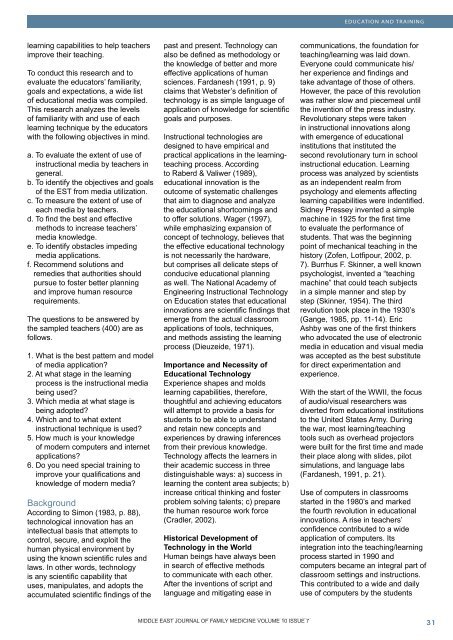full pdf of issue - Middle East Journal of Family Medicine
full pdf of issue - Middle East Journal of Family Medicine
full pdf of issue - Middle East Journal of Family Medicine
- No tags were found...
Create successful ePaper yourself
Turn your PDF publications into a flip-book with our unique Google optimized e-Paper software.
EDUCATION AND TRAININGlearning capabilities to help teachersimprove their teaching.To conduct this research and toevaluate the educators’ familiarity,goals and expectations, a wide list<strong>of</strong> educational media was compiled.This research analyzes the levels<strong>of</strong> familiarity with and use <strong>of</strong> eachlearning technique by the educatorswith the following objectives in mind.a. To evaluate the extent <strong>of</strong> use <strong>of</strong>instructional media by teachers ingeneral.b. To identify the objectives and goals<strong>of</strong> the EST from media utilization.c. To measure the extent <strong>of</strong> use <strong>of</strong>each media by teachers.d. To find the best and effectivemethods to increase teachers’media knowledge.e. To identify obstacles impedingmedia applications.f. Recommend solutions andremedies that authorities shouldpursue to foster better planningand improve human resourcerequirements.The questions to be answered bythe sampled teachers (400) are asfollows.1. What is the best pattern and model<strong>of</strong> media application?2. At what stage in the learningprocess is the instructional mediabeing used?3. Which media at what stage isbeing adopted?4. Which and to what extentinstructional technique is used?5. How much is your knowledge<strong>of</strong> modern computers and internetapplications?6. Do you need special training toimprove your qualifications andknowledge <strong>of</strong> modern media?BackgroundAccording to Simon (1983, p. 88),technological innovation has anintellectual basis that attempts tocontrol, secure, and exploit thehuman physical environment byusing the known scientific rules andlaws. In other words, technologyis any scientific capability thatuses, manipulates, and adopts theaccumulated scientific findings <strong>of</strong> thepast and present. Technology canalso be defined as methodology orthe knowledge <strong>of</strong> better and moreeffective applications <strong>of</strong> humansciences. Fardanesh (1991, p. 9)claims that Webster’s definition <strong>of</strong>technology is as simple language <strong>of</strong>application <strong>of</strong> knowledge for scientificgoals and purposes.Instructional technologies aredesigned to have empirical andpractical applications in the learningteachingprocess. Accordingto Raberd & Valiwer (1989),educational innovation is theoutcome <strong>of</strong> systematic challengesthat aim to diagnose and analyzethe educational shortcomings andto <strong>of</strong>fer solutions. Wager (1997),while emphasizing expansion <strong>of</strong>concept <strong>of</strong> technology, believes thatthe effective educational technologyis not necessarily the hardware,but comprises all delicate steps <strong>of</strong>conducive educational planningas well. The National Academy <strong>of</strong>Engineering Instructional Technologyon Education states that educationalinnovations are scientific findings thatemerge from the actual classroomapplications <strong>of</strong> tools, techniques,and methods assisting the learningprocess (Dieuzeide, 1971).Importance and Necessity <strong>of</strong>Educational TechnologyExperience shapes and moldslearning capabilities, therefore,thoughtful and achieving educatorswill attempt to provide a basis forstudents to be able to understandand retain new concepts andexperiences by drawing inferencesfrom their previous knowledge.Technology affects the learners intheir academic success in threedistinguishable ways: a) success inlearning the content area subjects; b)increase critical thinking and fosterproblem solving talents; c) preparethe human resource work force(Cradler, 2002).Historical Development <strong>of</strong>Technology in the WorldHuman beings have always beenin search <strong>of</strong> effective methodsto communicate with each other.After the inventions <strong>of</strong> script andlanguage and mitigating ease incommunications, the foundation forteaching/learning was laid down.Everyone could communicate his/her experience and findings andtake advantage <strong>of</strong> those <strong>of</strong> others.However, the pace <strong>of</strong> this revolutionwas rather slow and piecemeal untilthe invention <strong>of</strong> the press industry.Revolutionary steps were takenin instructional innovations alongwith emergence <strong>of</strong> educationalinstitutions that instituted thesecond revolutionary turn in schoolinstructional education. Learningprocess was analyzed by scientistsas an independent realm frompsychology and elements affectinglearning capabilities were indentified.Sidney Pressey invented a simplemachine in 1925 for the first timeto evaluate the performance <strong>of</strong>students. That was the beginningpoint <strong>of</strong> mechanical teaching in thehistory (Z<strong>of</strong>en, Lotfipour, 2002, p.7). Burrhus F. Skinner, a well knownpsychologist, invented a “teachingmachine” that could teach subjectsin a simple manner and step bystep (Skinner, 1954). The thirdrevolution took place in the 1930’s(Gange, 1985, pp. 11-14). EricAshby was one <strong>of</strong> the first thinkerswho advocated the use <strong>of</strong> electronicmedia in education and visual mediawas accepted as the best substitutefor direct experimentation andexperience.With the start <strong>of</strong> the WWII, the focus<strong>of</strong> audio/visual researchers wasdiverted from educational institutionsto the United States Army. Duringthe war, most learning/teachingtools such as overhead projectorswere built for the first time and madetheir place along with slides, pilotsimulations, and language labs(Fardanesh, 1991, p. 21).Use <strong>of</strong> computers in classroomsstarted in the 1980’s and markedthe fourth revolution in educationalinnovations. A rise in teachers’confidence contributed to a wideapplication <strong>of</strong> computers. Itsintegration into the teaching/learningprocess started in 1990 andcomputers became an integral part <strong>of</strong>classroom settings and instructions.This contributed to a wide and dailyuse <strong>of</strong> computers by the studentsMIDDLE MIDDLE EAST EAST JOURNAL JOURNAL OF OF OF FAMILY MEDICINE VOLUME • VOLUME 108 ISSUE 7, ISSUE 7510 31
















